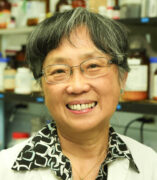
Leslie Fung
Professor Emerita
Contact
Address:
4444 SES, MC 111
Office Phone:
Email:
Related Sites:
About
We study a family of proteins - the spectrin isoforms. Spectrin, a major protein in the membrane skeleton or cytoskeleton, is believed to have evolved early in the development of metazoans, following divergence of fungi, plants and vertebrates, with each isoform representing a candidate for roles in specialized activities of multicellular animals.
The high degree of sequence homology amongst different spectrin isoforms suggests similar structures and similar functions for these isoforms. Yet, at least two of the better studied isoforms, erythroid and brain spectrins, exhibit quite different affinities in subunit interactions to form tetramers, which is the functional form for spectrin. The differences in affinities are probably due to small differences in conformation, or large differences in conformation of small areas (i.e. specific residue-residue pairing, kinetic differences in association, etc.). We are using various biophysical methods and recombinant model peptides of spectrin fragments to study differences in critical regions of brain and erythroid spectrin isoforms. The methods include cysteine scanning for spin or fluorescent labeling, as well as high resolution NMR and X-ray studies. Our broad, long-term objectives are to understand conformations of critical regions in various spectrin isoforms and to correlate specific structural features in these isoforms with functions unique to individual isoforms. Findings from these studies will provide insight toward developing molecular understanding of normal physiology involving spectrin molecules in erythrocytes, brain cells and other types of cells, and of diseases related to spectrin tetramers, such as hereditary hemolytic anemia blood diseases, and neurological disorders (e.g., many Alzheimer patients have elevated antibodies toward brain spectrin fragments).
These studies not only provide information on two important spectrin isoforms, but may also serve as examples for other highly homologous proteins with similar general folding patterns, that exhibit small conformational variations to provide functional differences.
We believe that disease markers and drug targets can be identified through functional proteomic studies of spectrin isoforms and their protein-protein interactions.
Molecular shapes/envelopes determined from the measured SAXS data of SpαI-1-156 (left, erythroid spectrin) and SpαII-1-149 (right, brain spectrin).
Ensemble structures for SpαI-1-156 calculated from NMR data.
Selected Publications
- Substrate independent ATPase activity may complicate high throughput screening.
Tuntland ML, Fung LW.
Analytical biochemistry. 2016; 510:18-20. NIHMSID: NIHMS805819
PubMed [journal]PMID: 27430931 PMCID: PMC4980188 - An Efficient and Economical Assay to Screen for Triclosan Binding to FabI.
Demissie RD, Kabre P, Tuntland ML, Fung LW.
Journal of biomolecular screening. 2016; 21(4):391-8.
PubMed [journal]PMID: 26538431 - Identification of B. anthracis N(5)-carboxyaminoimidazole ribonucleotide mutase (PurE) active site binding compounds via fragment library screening.
Lei H, Jones C, Zhu T, Patel K, Wolf NM, Fung LW, Lee H, Johnson ME.
Bioorganic & medicinal chemistry. 2016; 24(4):596-605.
PubMed [journal]PMID: 26740153 - Differences in the purification and solution properties of PurC gene products from Streptococcus pneumoniae and Bacillus anthracis.
Tuntland ML, Wolf NM, Fung LW.
Protein expression and purification. 2015; 114:143-8.
PubMed [journal]PMID: 26118696 - Identification of Bacillus anthracis PurE inhibitors with antimicrobial activity.
Kim A, Wolf NM, Zhu T, Johnson ME, Deng J, Cook JL, Fung LW.
Bioorganic & medicinal chemistry. 2015; 23(7):1492-9.
PubMed [journal]PMID: 25737087
Notable Honors
1975-1979, National Research Service Award, NIH
1981-1986, Research Career Development Awardee, NIH
Education
B.S. with Honors, University of California, Berkeley, 1968
Ph.D., Massachusetts Institute of Technology, 1971
Postdoctoral Fellow, Rice University, 1971-72
Lecturer, Chinese University of Hong Kong, 1972-1973
Postdoctoral Fellow, University of Pittsburgh, 1973-1977